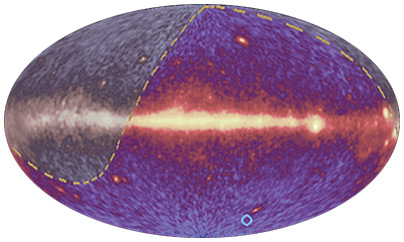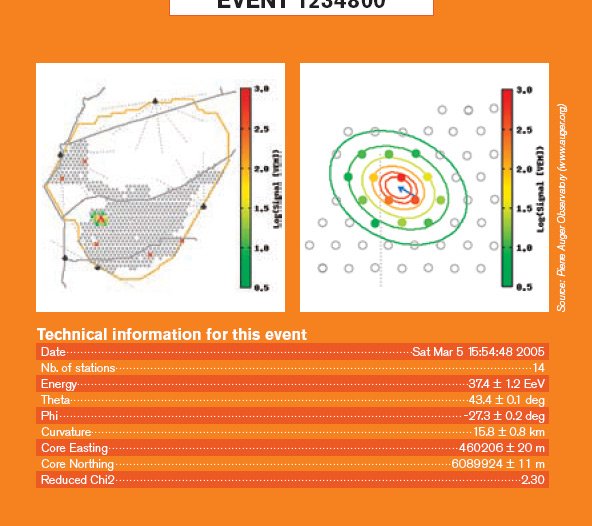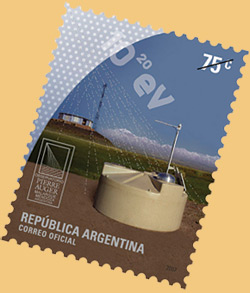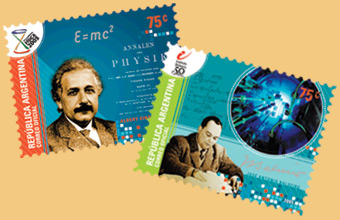 |
| This diagram shows data recorded by Pierre Auger Observatory on March 5, 2005. A cosmic ray hit the atmosphere at close to the speed of light, creating billions of secondary particles that rained down over the pampa and triggered 14 of 1500 surface detectors (colored dots.) Meanwhile, telescopes around the edge of the array watched for the faint glow of particles hitting nitrogen molecules in the atmosphere. Together these techniques allow scientists to trace the origins of the most energetic particles in the universe. |
| Source: Pierre Auger Observatory |
On the trail of cosmic bullets
By Kurt Riesselmann
Do the most energetic particles in the universe come from supermassive black holes? New results from the Pierre Auger Observatory make that case.
Argentina’s Pampa Amarilla is a rather remote place, a dry plain stretching thousands of miles against the spectacular backdrop of the rugged, snowcapped peaks of the Andes.
Like every other place on Earth, the yellow pampa is bathed in a constant shower of cosmic rays—protons and atomic nuclei that fly through the universe at close to the speed of light. While some are known to come from the sun, most take a meandering path that gives no clue to where they came from.
Once in a while, an unusually powerful cosmic ray strikes the Earth’s atmosphere with almost as much energy as a bullet. Fortunately, such a projectile is no danger to human life. Entering the atmosphere, it loses energy and creates showers of lower-energy particles, which can spread across more than 15 square miles by the time they hit ground.
What cosmic gun could possibly fire such a thing?
Here, among the grazing cattle and gauchos on horseback, scientists of the Pierre Auger Observatory, the world’s largest cosmic-ray observatory, are closing in on the answer.
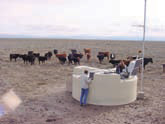 |
| Workers at one of the observatorys 1500 surface detectors draw the attention of a herd of cattle. Each detector contains 3000 gallons of water; when particles from a cosmic ray shower pass through the water, their shock waves produce Cherenkov light that is measured by photomultiplier tubes. The resulting signal is automatically transmitted via radio. Solar panels generate 20 watts of power needed to run the detector. |
| Photo: Pierre Auger Observatory |
Catching rays
“The highest-energy cosmic rays must come from some of the most violent processes in the universe,” says the US Department of Energy’s Dennis Kovar, acting associate director of the Office of Science for High Energy Physics. “Up until now we have known very little about their source.”
Based in Argentina’s Mendoza Province, near the town of Malargüe, the observatory is a model for international collaboration. Named after French physicist Pierre Auger, who discovered high-energy cosmic rays in 1938, the observatory involves 370 scientists and engineers from 17 countries. More than 40 funding agencies are sharing the US$54-million construction cost, with no country contributing more than a quarter of it.
Scattered across 1200 square miles of semi-arid land are what appear to be water tanks, spaced about a mile apart and painted beige to blend in with the landscape. Lined with photo sensors and sprouting solar panels and communications antennae, these Auger particle detectors have recorded about a million cosmic rays since January 2004, including about 100 ultrahigh-energy cosmic bullets—more than any other observatory has seen. The bullets are so rare that only one or two might hit each square mile per century.
“This result heralds a new window to the nearby universe and the beginning of cosmic-ray astronomy.” –Alan Watson
|
|||||||||||
Finding the smoking guns
In early November, the Pierre Auger team announced the first results of its effort to track cosmic bullets back to their sources. They looked at the 27 most energetic cosmic rays, those with energies of more than 57 billion billion electronvolts.
Rather than coming from points scattered across the sky, the tracks of most of these rays led straight back to nearby regions in space that are home to active galactic nuclei—supermassive black holes at the centers of some galaxies, such as Centaurus A. While other objects could reside in the same area of the sky, the Auger findings point to these black holes as the missing guns. The black hole at the center of our Milky Way galaxy is not an active nucleus and is not among them.
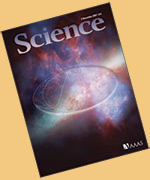 |
| The cover of the Nov. 9, 2007, issue of Science magazine, which shows an all-sky projection of highest-energy cosmic rays detected by the Pierre Auger Observatory (open circles) that are correlated with the positions of nearby quasars (crosses), a measure of the local galaxy distribution. The supergalactic and Milky Way planes are marked. The background shows a composite image of a nearby galaxy (M82) observed by NASAs Spitzer, Hubble, and Chandra space observatories. |
| Composite image: Kelly Krause/Science (figure: Auger Collaboration; photo: NASA / JPL-Caltech / STScI / Chandra X-ray Center / Univ. of Arizona / ESA / AURA / Johns Hopkins Univ.) |
Active galactic nuclei are a million to billions of times as massive as our sun. They may be the products of galactic collisions or other cataclysmic disruptions in their home galaxies within the past few hundred million years.
As they devour huge amounts of gas, dust, and other matter, they create and eject prodigious amounts of energy and particles. If, as the Auger findings suggest, they are responsible for firing cosmic bullets, they are the most powerful accelerators in the universe, propelling particles to energies 100 million times higher than any earthly particle accelerator has achieved.
“We have taken a big step forward in solving the mystery of the nature and origin of the highest-energy cosmic rays,” says Nobel Prize winner James Cronin, of the University of Chicago, who conceived the Pierre Auger Observatory with Alan Watson of the University of Leeds. “This is a fundamental discovery.”
Most cosmic rays travel in gently curving, unpredictable lines, deflected by magnetic fields as they make their way through the universe. They also lose energy as they interact with the ever-present bath of the cosmic microwave background—the afterglow of the big bang. But rays that travel at very high energy are barely deflected. Even after traveling a few hundred million light years—a relatively short distance, on a cosmic scale—they still point back within a few degrees of their sources.
“The challenge now is to record enough of these cosmic bullets to understand the processes that hurl them into space,” says project manager Paul Mantsch of Fermi National Accelerator Laboratory in Batavia, Illinois, which hosts the observatory’s project management office.
A world record
The mystery of the cosmic bullets dates back almost 70 years, when Pierre Auger measured the range of individual showers of cosmic rays. Based on his results he calculated that some cosmic rays must arrive with energies in excess of a million billion electronvolts. At a time when scientists had discovered neither pulsars nor black holes, no one could begin to imagine the cosmic objects that could accelerate particles to such ultrahigh energies.
The mystery behind Auger’s results inspired future generations of physicists to build larger and more sophisticated air-shower detectors. In 1991, the University of Utah’s Fly’s Eye Cosmic Ray Detector recorded a shower that was triggered by a cosmic ray with an energy of more than 300 billion billion electronvolts, or about 50 Joules—the kinetic energy of a small bullet packed into the tiny volume of a single particle. It still holds the world record for the most energetic particle ever measured.
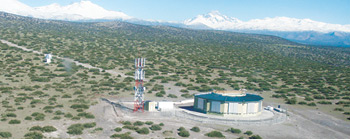 |
| One of four buildings that contain a total of 24 fluorescence telescopes. Together they cover the sky over the observatory, looking for the faint glow created when billions of particles from a cosmic ray shower interact with nitrogen molecules in the atmosphere. |
| Photo: Pierre Auger Observatory |
In the next few years our data will permit us to identify the exact sources of these cosmic rays and how they accelerate these particles. –James Cronin
Observations made in the last 15 years have yielded a few more ultrahigh-energy events. The 40-square-mile Akeno Giant Air Shower Array in Japan, for example, recorded data from 1993 to 2004 using particle detectors filled with water. Every time a charged particle crossed through a tank, it emitted a bluish streak of light. Photo sensors inside the tanks counted the number and intensity of the streaks.
The Hi-Res observatory in Utah, which operated from 1997 to 2006, pioneered a new technology: it observed cosmic rays using two fluorescence telescopes. On moonless nights, these instruments can record the faint glow of air showers, which cause nitrogen molecules in the air to fluoresce.
The Auger collaboration took the methods used by AGASA and Hi-Res and expanded them to a larger scale. Its array of water tanks covers an area 30 times larger than the AGASA array; 24 fluorescence telescopes watch over the pampa at night.
So far, 1500 of the planned 1600 particle detectors and all the fluorescence telescopes have been installed. The collaboration expects to collect about 30 ultrahigh-energy cosmic rays per year.
“In the next few years our data will permit us to identify the exact sources of these cosmic rays and how they accelerate these particles,” says Cronin.
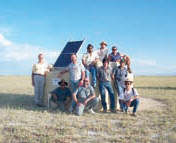 |
| The first surface detector in the Pierre Auger array, installed in 2000. More than 280 physicists from 17 countries are collaborating to build the observatory. |
| Photo: Pierre Auger Observatory |
The dawn of cosmic-ray astronomy
Although cosmic-ray astronomy is challenging, Auger scientists think their observatory has the potential to pave the way to many more discoveries. They’re developing plans for a second, larger installation in Colorado that, together with the one in Argentina, would give them access to the entire sky.
“A northern site would let us look at more galaxies and black holes, increasing the sensitivity of our observatory,” says Auger co-spokesperson Giorgio Matthiae, of the University of Rome. And there are even more active galactic nuclei in the northern sky than in the south.
For Watson and his colleagues, cosmic rays are a new way of looking at the universe. Scientists have relied on light (from infrared to gamma rays), radio waves, and—more recently—neutrinos to gather information about objects in space. If recorded in sufficient numbers, the highest-energy cosmic rays would convey information about objects, from the interiors of stars to active galactic nuclei, that is not available by any other means.
“This result heralds a new window to the nearby universe and the beginning of cosmic-ray astronomy,” says Watson, co-founder and spokesperson for the observatory. “As we collect more and more data, we may look at individual galaxies in a detailed and completely new way.”
Q&A It’s not often that an observatory is featured on a postage stamp. Rhianna Wisniewski talks with Ingo Allekotte, deputy project manager at the Pierre Auger Observatory, about a stamp recently issued by the Argentine postal service. RW: How did the idea for the stamp originate? Whenever they have a stamp release, they have a small brochure with information about what the stamp is about. So they made a leaflet, which is four pages long. They also have an envelope on the first day, and they put a postmark and stamp on the envelope. This is distributed to subscribers and post offices. The stamp was released July 14. How much is the stamp? What were those first designs the mail company brought you? In the first drawing, rather than having the shower coming from one common origin—that is, from one primary cosmic ray that produces the shower—they had drawn the shower coming from many different directions, which is not the case.
How did you explain that to them? So having all three elements in this stamp—the detector, the fluorescence detector building, and the cosmic rays—was very important? How unusual is it for Argentina to release stamps on scientific projects? The Auger stamp is part of a series that is called “Cosmos and Science.” There was one more stamp in this series released this year. It is about a meteorite field in the north of Argentina, and contains a meteorite.
The observatory has a large international collaboration. How important was it to the collaboration that this stamp was made? Do you have any other outreach efforts? Is there anything else about the stamp that you think might be interesting to note? |
Click here to download the pdf version of this article.



